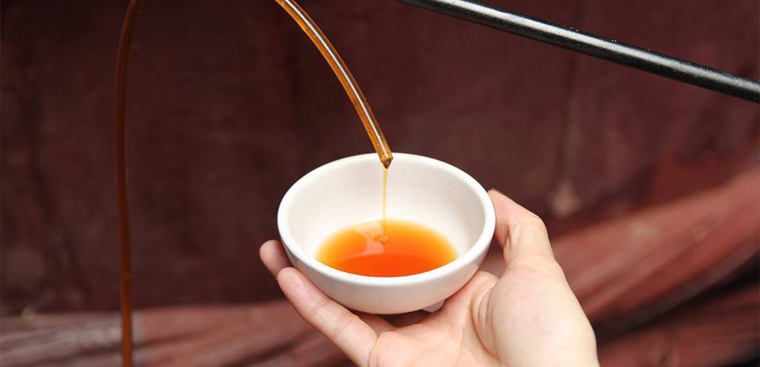Fish sauce is a liquid condiment made from fish that have been coated in salt and fermented for at least two years. It is widely used as a main seasoning in East and Southeast Asian cuisine.
Following widespread recognition of its ability to impart a savory umami flavor to dishes, it has been embraced globally by chefs and home cooks. The umami flavor in fish sauce is due to its glutamate content.
Soy sauce is regarded by some in the West as a vegetarian alternative to fish sauce though they are very different in flavor.
Fish sauce is not only added to dishes as a seasoning, but also used as a base in dipping sauces.

Ingredients and manufacture
Fish sauces historically have been prepared from different species of fish and shellfish, and from using the whole fish, or by using just fish blood or viscera. Most modern fish sauces contain only fish and salt, usually made from anchovy, shrimp, mackerel, or other strong-flavored, high oil fish. Some variants add herbs and spices. For modern fish sauces, fish or shellfish is mixed with salt at a concentration of 10% to 30%. It is then sealed in a closed container for up to two years.
Once the original draft has been made, some fish sauces will be produced through a re-extraction of the fish mass via boiling. To improve the visual appearance and add taste, second-pass fish sauces often have added caramel, molasses, or roasted rice. They are thinner, and less costly. Some volume manufacturers of fish sauce will also water down a first-press to manufacture more product.
Fish sauce that has been only briefly fermented has a pronounced fishy taste. Extended fermentation reduces this and gives the product a nuttier, richer and more savory flavor.


Nutrition contents
Common commercial brands of fish sauce generally contain about 50% to 60% of the FDA’s daily recommended amount of sodium per tablespoon serving. Most commercial brands of reasonable quality contain one or two grams of protein per serving; however, higher-quality brands may have four grams of protein or more, while lower-quality brands may have less than one gram of protein per serving. Fish sauce has an insignificant amount of carbohydrates and fats. Vitamin B12, vitamin B-6, and magnesium are present in small amounts.

Fish sauce in Vietnam
The origin of fish sauce in Vietnam dates back to ancient times as a primary source of protein. Early fishing boats were unable to venture into the deep ocean to catch larger fish for more fish meat. Instead, they mostly stayed close to the shore and net small fish. Later on, it was found that they could produce a richer protein sauce by layering these small fish in barrels with salt. Since then, there appeared such a delicious sauce!
Two areas in Vietnam are most famous for producing fish sauce: Phú Quốc and Phan Thiết.
Vietnamese fish sauces are made with anchovies, mackerel, scabbard fish and salt. High mercury concentration can be found in larger fish, especially if predator fish like scabbard fish. They do not have any additives like sugar, hydrolyzed protein, or preservatives. Vietnamese prefer sauces without a strong smell, and transparent with a deep golden amber color. “First press” fish sauce, meaning the sauce is bottled from the first time the fermenting barrels are drained, also indicates quality. Lastly, when measuring the nitrogen level of fish sauces (N), most fish sauce on the market falls within the mid 20N range. Anything over 30N is considered high-grade, and 40N is optimal.
Nước chấm is a Vietnamese prepared fish-based condiment (also referred to as a “sauce”) that is savory, lightly sweet and salty tasting, and can be sour and spicy if lime and chili peppers are added. The main components are fish sauce, water, and sugar.
Mắm is made much like fish sauce, except that it is not fermented as long, and the fish is kept along with its liquid extract, not just the extract. Mắm can be used as a base condiment in dipping sauces with additional ingredients or used in soups or stir-fries.
How to use fish sauce
Fish sauce is one of those ingredients that may seem a little scary, especially when you get that first whiff of it upon opening the bottle. But don’t be turned off by the smell. It hasn’t gone bad… that’s kind of just the way it smells. It’s fermented fish!
It adds a savory umami element to dishes, and a slight seafood flavor, and it can be used similar to how anchovies are used in Mediterranean cuisine––to add flavor and complexity.
It is also very salty, so use a light hand. Some cooks use it in place of salt, and it will yield the most flavorful, high quality dishes.
We also like to add a splash to our fried rice dishes sometimes, and it does wonders for the flavor! Fish sauce is also a key ingredient in dipping sauces and dressings, like Vietnamese nuoc cham, which is served with spring rolls/summer rolls and noodle salads.




Buying & Storing
Any high-quality brand will do! They range in price and quality, depending on how long they were fermented and how pure they are (i.e. fish sauces with less added sugar and fewer additives).
Fish sauce is a fermented ingredient, and it does not need to be refrigerated. Store in a cool, dry place like the pantry. It has a shelf life of about 1 year. If you’re going to keep it beyond one year, you can refrigerate it.
Substitutions for fish sauce
You can find fish sauce in any Asian market, or even in some supermarkets these days. If, however, you can’t find it, you can substitute a bit of soy sauce and some finely minced anchovies.
If you’re vegan or have a seafood or shellfish allergy, you can substitute mushroom flavored soy sauce, which will provide both the salt and umami elements. The flavor won’t be quite as rich, but it’ll do in a pinch!

MLD CO., LTD – FMCG Export
Ho Chi Minh City, Vietnam | Hotline: +84 979 190 639 | [email protected]


